Gordon Grice's Blog, page 59
April 16, 2012
Alligators Delivered to Your Room

Alligator visits the Super 8:
Authorities in Louisiana say a 6-foot alligator showed up at the front door of a Super 8 Motel outside Baton Rouge and bit a guest.
West Baton Rouge Parish Sheriff Mike Cazes tells The Advocate (http://bit.ly/HN7YDO) his office got the call about the alligator around 4 p.m. Wednesday in Port Allen.
Matt Marszal, the motel's front desk clerk, says the gator bit one of the motel guests who tried to catch it before Animal Control workers showed up.
Published on April 16, 2012 08:30
April 12, 2012
More Lions, More Leopards, Fewer Humans
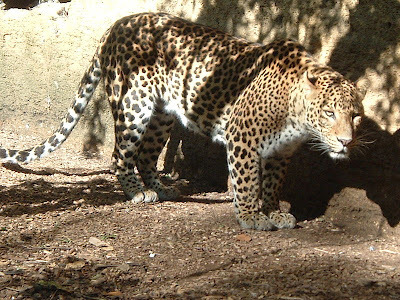
In the Gir Forrest, home to Asia's only remaining population of lions, rising numbers of both big cats may be pushing leopards into conflict with humans:
Growing population: Leopards struggle in lions' den, prowl outside Gir - Indian Express:
""All the children who have fallen prey (to leopards) in the last couple of days are of labourers working in agricultural fields or mines," said Principal Conservator of Forest K Gohel. Forest teams led by Gohel asked labourers to take precautions like avoiding sleeping in the open. They were specifically asked not to eat and throw non-vegetarian cooked food in the open.
The incidents have led to changes in the lifestyle in the coastal belts of Veraval, from where all the recent incidents were reported. Labourers no longer work after sunset and prefer to work only in groups during the day. "Parents now accompany their children on their way to school and also while returning home. Children are no longer allowed to play in the fields," said Umeshsing, a labourer."
Meanwhile, the Indian government has released last year's stats on animal attacks in the Gir:
Gir wild cats mauled 10 to death in a year - Times Of India:
"Lions and leopards killed at least 10 persons in Junagadh district in the past one year. The state government has revealed that 1,966 attacks on cattle and 60 attacks on humans have been reported in the same period.
In a written reply to a question by MLA Dhirsinh Barad, the government said that in the 60 attacks, 10 people died and 52 were injured in the year ending January 31."
Published on April 12, 2012 09:00
April 11, 2012
Hairless
 Seweryn Olkowicz/Creative Commons
Seweryn Olkowicz/Creative CommonsIn a little desert town where I had business that fellthrough, I walked the streets. Downtownwas crumbling brick and mortar, signs inviting civic pride and promisingrenovation. Another sign, felt-tipmarker and stencil: "Exotic Snake Show."
Inside I found a flight of cement steps, each step toonarrow for my boots, each vertical face eroded as if by a waterfall. There were patches of whitewash on the mintgreen plaster walls. At the top of thestairs I found a room empty except for a table where a man stood with a cigarbox full of cash.
"Where's the show?" I said.
He nodded toward the next room, a huge loft. It was empty except for one corner where peoplestood around a few cages. "Just ask themand they'll show you stuff," the man said.
I paid two dollars and walked over to the cages. A youngwoman with moussed auburn hair sat in a folding chair. Wound around her arm was a thick strand ofblack patched with gold like puddles of liquid electricity.
The woman spoke the python's name. When she turned to look at me I saw alightning bolt painted on the left side of her face. I looked for the snake's head, finally tracedits body to an end which nuzzled under the woman's shirt. The woman looked at me withoutexpectation. She did not blink.
Someone called her from the other room. She held the snake out to me, extricating itfrom her clothes, gently raveling. Ioffered my hands. The python wrappeditself around my arm. The woman ran intothe next room. The python was dry andlight and alive, the power beneath its hide palpable.
 Dee Puett
Dee PuettA Chinese take-out carton on the table next to me scootedand rocked. Inside, wallowing in theoily remnants of fried noodles, six infant mice sniffed and twitched. They were pink and blind and naked and notunlike human fetuses. Another one layin a cage, its side rising with its breath. A tiny python had found it. Thelithe black tongue trickled in and out, caressing the pink mouse, tasting,taking its time.
Related Post: Python in the Fence
Originally published in Food Chain.
Published on April 11, 2012 04:30
April 10, 2012
Birth of a Giraffe, Attended by Vultures
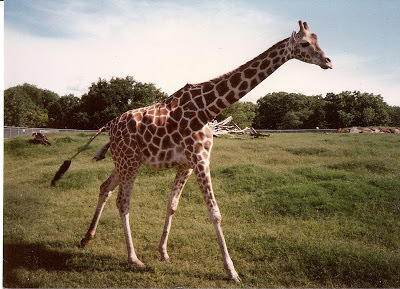 Giraffe in labor; note the calf's hooves protruding.
Giraffe in labor; note the calf's hooves protruding.Tracy and I witnessed this birth at the Oklahoma City Zoo years ago. She was the first to notice the giraffe was in labor. "What's that sticking out of that giraffe?" she said. A closer look revealed that it was tiny hooves. We alerted the zoo employees, who stood and watched with us. ("What's the time table here?" another visitor asked impatiently.)
 Birth in progress; vultures await a chance to snatch placenta or calf.
Birth in progress; vultures await a chance to snatch placenta or calf.  Birth--the calf falls head-first, a drop of about six feet.
Birth--the calf falls head-first, a drop of about six feet.The calf seemed healthy; the vultures went hungry.
Photos by Tracy.
Published on April 10, 2012 09:00
April 9, 2012
Mark Twain's Storm
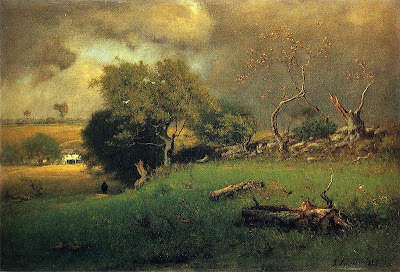
In his new book I Must Not Think Bad Thoughts: Drive-by Essays on American Dread, American Dreams
 , Mark Dery has a lot to say about Mark Twain, some of which was so exciting it caused Dery to get booted off Facebook for a while. Of interest to us on this blog, however, are Twain's exquisite descriptions of nature. Here's a passage from The Adventures of Tom Sawyer that Dery describes as "a Caspar David Friedrich painting in prose." I, however, find George Inness the premier painter of storms, so I pasted one at the top of this post.
, Mark Dery has a lot to say about Mark Twain, some of which was so exciting it caused Dery to get booted off Facebook for a while. Of interest to us on this blog, however, are Twain's exquisite descriptions of nature. Here's a passage from The Adventures of Tom Sawyer that Dery describes as "a Caspar David Friedrich painting in prose." I, however, find George Inness the premier painter of storms, so I pasted one at the top of this post. There was a brooding oppressiveness in the air that seemed to bode something. The boys huddled themselves together and sought the friendly companionship of the fire, though the dull dead heat of the breathless atmosphere was stifling. They sat still, intent and waiting. The solemn hush continued. Beyond the light of the fire everything was swallowed up in the blackness of darkness. Presently there came a quivering glow that vaguely revealed the foliage for a moment and then vanished. By and by another came, a little stronger. Then another. Then a faint moan came sighing through the branches of the forest and the boys felt a fleeting breath upon their cheeks, and shuddered with the fancy that the Spirit of the Night had gone by. There was a pause. Now a weird flash turned night into day and showed every little grassblade, separate and distinct, that grew about their feet. And it showed three white, startled faces, too. A deep peal of thunder went rolling and tumbling down the heavens and lost itself in sullen rumblings in the distance. A sweep of chilly air passed by, rustling all the leaves and snowing the flaky ashes broadcast about the fire. Another fierce glare lit up the forest and an instant crash followed that seemed to rend the treetops right over the boys' heads. They clung together in terror, in the thick gloom that followed. A few big raindrops fell pattering upon the leaves.
"Quick! boys, go for the tent!" exclaimed Tom.
They sprang away, stumbling over roots and among vines in the dark, no two plunging in the same direction. A furious blast roared through the trees, making everything sing as it went. One blinding flash after another came, and peal on peal of deafening thunder. And now a drenching rain poured down and the rising hurricane drove it in sheets along the ground. The boys cried out to each other, but the roaring wind and the booming thunderblasts drowned their voices utterly. However, one by one they straggled in at last and took shelter under the tent, cold, scared, and streaming with water; but to have company in misery seemed something to be grateful for. They could not talk, the old sail flapped so furiously, even if the other noises would have allowed them. The tempest rose higher and higher, and presently the sail tore loose from its fastenings and went winging away on the blast. The boys seized each others' hands and fled, with many tumblings and bruises, to the shelter of a great oak that stood upon the riverbank. Now the battle was at its highest. Under the ceaseless conflagration of lightning that flamed in the skies, everything below stood out in cleancut and shadowless distinctness: the bending trees, the billowy river, white with foam, the driving spray of spumeflakes, the dim outlines of the high bluffs on the other side, glimpsed through the drifting cloudrack and the slanting veil of rain. Every little while some giant tree yielded the fight and fell crashing through the younger growth; and the unflagging thunderpeals came now in ear-splitting explosive bursts, keen and sharp, and unspeakably appalling. The storm culminated in one matchless effort that seemed likely to tear the island to pieces, burn it up, drown it to the treetops, blow it away, and deafen every creature in it, all at one and the same moment. It was a wild night for homeless young heads to be out in.
But at last the battle was done, and the forces retired with weaker and weaker threatenings and grumblings, and peace resumed her sway. The boys went back to camp, a good deal awed; but they found there was still something to be thankful for, because the great sycamore, the shelter of their beds, was a ruin, now, blasted by the lightnings, and they were not under it when the catastrophe happened.
Everything in camp was drenched, the campfire as well; for they were but heedless lads, like their generation, and had made no provision against rain. Here was matter for dismay, for they were soaked through and chilled. They were eloquent in their distress; but they presently discovered that the fire had eaten so far up under the great log it had been built against (where it curved upward and separated itself from the ground), that a handbreadth or so of it had escaped wetting; so they patiently wrought until, with shreds and bark gathered from the under sides of sheltered logs, they coaxed the fire to burn again. Then they piled on great dead boughs till they had a roaring furnace, and were gladhearted once more. They dried their boiled ham and had a feast, and after that they sat by the fire and expanded and glorified their midnight adventure until morning, for there was not a dry spot to sleep on, anywhere around.
OK, I admit Friedrich is a great painter, so let's give him the last word:
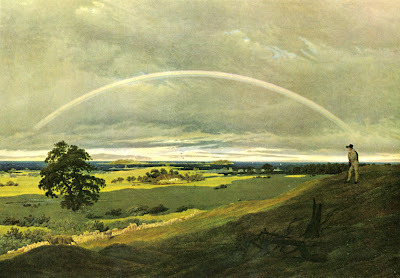
More of Dery's selections from Twain to come.
Published on April 09, 2012 09:00
April 8, 2012
Crocodile Bites Woman
 Wiki mouse/GNU Free LicenseIn South Africa, a woman has been killed in an attack by a Nile crocodile:
Wiki mouse/GNU Free LicenseIn South Africa, a woman has been killed in an attack by a Nile crocodile:Fatal croc attack 'an isolated incident' - The Mercury | IOL.co.za: "Madela had been trying to retrieve her fish when a crocodile grabbed her arm and dragged her into the water in full view of her son Sphelele, 12, and grandson Ayanda, 11.
The children used a fishing rod to try and fend off the crocodile, but it vanished under the water with Madela.
Thembinkosi Mdladla, 28, who had been nearby, held children back as they tried to jump in the water when the crocodile emerged with Madela's body in its jaws."
In Australia, another woman had better luck:
Crocodile attacks woman in waist-deep water:
"A crocodile has bitten a woman on the leg while she was swimming at a remote bay in Western Australia's Kimberley region.
Tara Hawkes, 23, was swimming in a freshwater pool near the tourist vessel True North in Dugong Bay north of Derby on Sunday afternoon when a two-metre crocodile bit her upper leg as she left the water.
Ms Hawkes, who was a crew member on the boat, was flown by helicopter to Derby Hospital where she was in a stable condition on Monday night being treated for lacerations and puncture wounds."
The Australian article mentions the possibility that the attacker was a freshwater crocodile. That would be an extremely rare occurrence. Freshies, with their slender snouts, are adapted for hunting fish; and while they can certainly bite people with effect when irritated, they don't prey on us. It's far more likely to have been a young saltwater crocodile (both species can live in fresh water; the saltie just has options). The photo above shows a young freshie in a zoo.
Published on April 08, 2012 09:00
April 7, 2012
Great White Shark vs. Knife
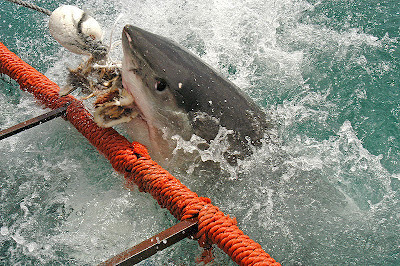 Pietervisser/Creative Commons
Pietervisser/Creative CommonsFriend says weekend shark victim laughed off risk of attack | The Australian:
"Mr Kurmann was attacked off Stratham Beach - about 230km south of Perth near Busselton - while diving with his older brother Gian, who tried to fight off the shark with his diving knife.
"He had a go at the shark with his knife," friend Peter MacDonald said. "They were both descending down the anchor rope to the dive site and Peter was in front of Gian and apparently it came out of nowhere and grabbed him.""
Published on April 07, 2012 09:00
April 6, 2012
Dingo Attacks on Fraser Island
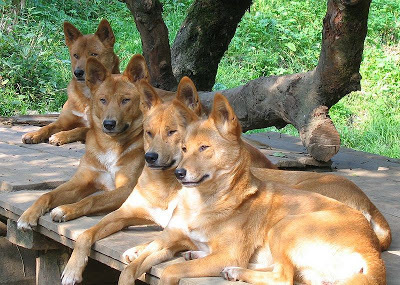 PartnerHund/Creative Commons
PartnerHund/Creative CommonsFraser Is visitors warned of dingo attacks - ABC News (Australian Broadcasting Corporation):
"Holiday-makers planning to visit Fraser Island, off south-east Queensland, are being warned to take extra precautions after five dingo attacks in the past fortnight.
The Queensland Parks and Wildlife Service says the Easter holiday period also coincides with the dingo breeding season which can make the animals more aggressive."
Published on April 06, 2012 09:00
April 5, 2012
Cougar Tales, Part 2

Deadly Animals: Savage Encounters Between Man and Beast is now on sale in the United Kingdom. As with earlier editions, I'm celebrating by showing off expanded versions of tales from the book--specifically, a couple of stories about cougars, also known as mountain lions or pumas.
(This story originally appeared in a different form in Discover; it was reprinted in The Best American Science and Nature Writing.)
I and a dozen others were staying at a ranch house, where wewere guests at a wedding. Some of uswent out for a ride. Our horses' shoesclapped against the steep granite as we worked our way around the mountain'sshoulder. Then we were into a stretch ofopen field. My horse, a big, unruly bay,trudged through a clattering pile of bones. I reined him in and asked Virgil, the wrangler, about the carcass. We dismounted.
Virgil handed me the skull. It was about as long as my hand, equipped with broad molars for chewingvegetation. The front of the mouthlacked teeth.
"Pronghorn antelope," Virgil said. "They don't have front teeth. They use their lips to pull in grass andleaves."
The horns themselves were gone. We looked the bones over to see if we couldfigure out what had killed the pronghorn. We found plenty of marks, any of which could have conveyed informationto somebody who knew about such things, but neither of us had spent much timelearning to read bones.
"These look like something chewed them," I said, holding upa femur and an uncertain fragment.
"Could be," Virgil said. "We've got coyotes and mountain lions. Of course, it could have dropped dead of a disease and then anythingcould chew on it. God knows how longit's been here."
The skull still had some soft gristle and a flap of hideattached. It had the heft of somethingnot yet empty. I didn't think it was tooold. I tied it to my saddle to take backto the ranch house. A pair of sluggishgray bullets emerged from an eye socket and crawled down opposite sides of thenose: carrion beetles.
*
At the ranch house I scrounged a five-gallon bucket andfilled it with water. When I immersedthe skull, dozens of carrion beetles came struggling out from the eye socketsand the infinite papery complications of the nasal cavity.
A three-year-old boy watched me unblinkingly. He turned to whisper something to hisuncle. I had seen them earlier hiking alittle way into the hills. They hadstood over the leg bones of a deer and talked a long while. The uncle had reported the conversation to me:the boy asking how the bones "fell out" of the animal, the uncle trying toexplain death as "going back to the earth." Now they huddled again, apparently discussing the pronghorn skull andits colonizers.
I went to work cleaning the skull and forgot about thelittle boy. When I looked up I found himstanding on the porch above me, staring. I had just plunged the skull into a fresh bucketful of water, and a newset of carrion beetles came out in a panic, as if they had slept through thefirst dowsing. They crawled over eachother to stay above water. The boystared at the water troubled by the struggling gray beetles, the slender skullgazing back from the bottom of the bucket.
"The bugs help him go back to the earth," the boypronounced, and aimed his toy six-shooter at my heart.
*
The ranch served us bacon and eggs every morning. As we walked to the bunkhouse, led by thesmell of bacon, we had to pass the pig pen. The next morning I stopped to lean on the rails of the pen and look thepigs over. There were five, all patchedwith brown and white except for one plump pink hog. I wondered what pigs think of the smell ofbacon.
Virgil came up and leaned on the rail next to me. I declined the bent Marlboro he offered. I kicked idly at the fence where a freshpiece of lumber stood out among the weather-beaten planks and posts.
"I put that on last week," Virgil said. "A mountain lion tore the old board off."
The story that emerged was this: Virgil had waked to thescreams of the pink hog. The mountainlion had it by the hind leg and was trying to drag it through the break in thefence. Virgil fired a shotgun in the airto scare the cat off. I could see adeep, black seam of healing wound on the hog's leg. I asked whether the cat had been back since.
"Not up here close to the house," he said. He had gone fishing at a stock pond two daysearlier. When his horse started acting"spooky," he packed his gear and headed for the ranch house. He returned to the pond later thatafternoon. The mountain lion's tracksled down to the fallen log at the water's edge where he had sat fishing.
Near dusk Virgil asked me to help him drive a few head ofcattle into their evening pasture. Thecattle knew the drill; all we had to do was keep them moving. We did it on foot.
We were walking a dirt road, the cattle hustling a few yardsahead of us. On our left was a fencedpasture; on our right was heavy brush. The road changed abruptly from hard-packed dirt to a patch wherefrequent run-off from a hill had left soft, smooth undulations of dirt. That's where I spotted the pug-marks of themountain lion. They dappled the road ina straight line for several yards, obscured in two places where the cattle hadcrossed them. A good rain had fallenabout two hours earlier, and we thought the tracks must have been made sincethen. We argued briefly about whethermountain lions would be prowling at that hour.
Soon we had the cattle in their pasture. Virgil wrestled the gate shut; it was broken,so the process took him a few minutes. Suddenly we both looked toward the brush, then at each other, then backat the brush. I scanned the bank of bushesand ditch-grass and tangled trees.
Virgil whispered a long string of profanities. He told me later he had heard something atthat moment, a subtle click that might have been the breaking of a twig. I'm pretty sure I didn't hear anything. I just suddenly got a cold feeling in myscalp, and I knew I was being watched. Virgil and I started toward the ranch house, he cursing steadily. We both walked slowly. I puffed myself up to look large. Virgil was smaller than I and would make amore inviting target, I reflected. Inoticed he kept me between himself and the brush. "Wish I had my damn shotgun," he said.
We stopped simultaneously. No signal passed between us, but we must have been thinking the samething. A thick clump of brush juttedinto the road ahead of us, and neither of us wanted to go near it. I stomped on a branch that lay in the road,breaking off a manageable truncheon. Virgil picked up a chunk of sandstone. We walked past the bush, and suddenly we were talking about the weatherin loud, angry voices, agreeing that it was nice but a little damp in tones thatsuggested we were planning to kill each other.
We could see the ranch house up the road. Soon we could see our friends lounging on theveranda. We walked slowly, taking turnsproclaiming the damn niceness of the weather over our shoulders. I suppose we thought the presence in thebrush might fear our loud voices.
A conversation about politics drifted down from the veranda;someone quipped and several laughed. Whycouldn't they shout down the road to us? Or decide to meet us halfway? Finally we were in the yard and away from the brush.
There is no exciting finish to the story. We were safe. Our friends told us we were the victims of imagination. The next day I followed our tracks along theroad to the evening pasture. A fresh setof pugmarks led toward the house. Theyran between Virgil's prints and mine, and occasionally turned a circle beforerejoining our path. One pugmark fellneatly within the spade-shaped impression of my left boot, four blunt toes anda trapezoidal foot pad deepening the dent of my print.
I took the pronghorn skull home when I left the ranch. A fizzing denture cleaner hardly changed itsdirty exterior. I had to throw it outafter a couple of days, when it began to smell like bad chicken broth. It was a poor souvenir. There was too much life left in it.
Published on April 05, 2012 09:00
April 4, 2012
Cougar Tales, Part 1

Deadly Animals makes its debut in the United Kingdom tomorrow! This is the paperback version of The Book of Deadly Animals. As with earlier editions, I'm celebrating by showing off expanded versions of tales from the book--specifically, a couple of stories about cougars, also known as mountain lions or pumas. Here's the first; I'll post another one tomorrow.
(This story originally appeared in a different form in Discover; it was reprinted in The Best American Science and Nature Writing.)
*
When he kicked it, the cow's head flipped completelyover. It lay flat, the desiccated andcracked pink nose pointing opposite to the way it had lain before. The spine was broken.
The man--I'll call him Harris because, although he feelshe's done nothing wrong, he's not anxious for authorities to know his realname--had found the cow by following drag marks. The trail was speckled with droplets offrozen blood. Twenty-five yards from atrampled spot in the snow where the cow must have died, the trail crossed afrozen puddle and ended beneath the shaggy limbs of a red cedar. Alive, the cow had weighed 900 pounds; now itwas probably lighter by fifty pounds or so, all of which had been wrenched andtorn from its shoulder. The carnivorehad taken great mouthfuls of hair, hide, and muscle indiscriminately, burrowingstraight into the carcass as an earthworm engulfs the dirt in its path. The cow's bones were broken and pulled out ofjoint. The ragged hide around the woundhad already hardened like tanned leather and curled out like the petals of arose.
When wild animals took livestock on this little ranch justnorth of the Colorado-New Mexico border, coyotes were the usual culprits. The damage to this cow's carcass showed thatnothing as small as a coyote was to blame. Crows hopping around in the snow to scavenge the carcass had obliteratedany tracks the carnivore might have left.
Harris had heard his neighbors speak of deer carcassesthey'd found in the ditches, half-eaten and thinly covered with scratched-upgrass. He guessed mountain lions hadcome back to the county. He was halfright.
*
When I visited one late November, everyone was buzzing aboutthe ranch's best saddle horse. A fewmornings after the discovery of the cow's carcass, the horse came inwounded. Parallel claw marks ranhorizontally along its flank, like a musical staff drawn in blood.
Harris searched the spot where the horse had pastured thenight before. He found a few straypugmarks, each showing four toes and the M-shaped ball of the foot. Since the tracks showed no evidence of claws,he felt safe in ruling out dogs and coyotes. An animal capable of retracting its claws had made these tracks. A cat.
A few days later a gravid cow went missing. When he found her in a narrow canyon, she hadalready given birth. The calf wasnowhere to be found. Two more weekspassed. This time an older Hereford calfwas missing. He never found it either,but he watched the crows until their gathering showed him the killingplace. When he rode up he found plentyof crows on the ground. They werepecking at small objects in the grass. When he dismounted they turned their heads to watch him with theirindifferent blue-black eyes. They lookedas if they might hold their ground, but when Harris was a few steps away theyall simultaneously stretched their dark feathered hands and leaned forward intoflight. He examined the ground. Tufts of the calf's red and white fur layeverywhere. A cat's tongue is studdedwith spikes that can flense cartilage from bone more efficiently than any sortof teeth could. Or perhaps the predatorhad simply vomited the hair up, the way domestic cats regurgitate hairballs. A few slivers and chips of bloody bone layscattered among the fur. Nothing elseremained of the calf.
*
In the ensuing weeks Harris consulted his neighbors, guardedhis livestock as best he could, watched for signs. An easily forded stretch of creek taught himmuch about the mountain lion on his spread. Fresh tracks appeared there every five or six weeks, as if the cat werepatrolling a large area. The territoryof a male mountain lion can cover 100 square miles.
Harris and his neighbors compared notes and found twopatterns among the carcasses of livestock and deer on their ranches. Some animals, such as the first cow Harrishad lost, were killed by sledgehammer blows to the head. Flesh and bones were devoured, withoutpreference, from a single massive wound. The carcass, even a partly-eaten one, lay in the open, neverburied. A few such kill sites not yetspoiled by crows and coyotes revealed tracks that might have been left by astunted man with blunt, bent feet. Thesekills were the work of a black bear, not a mountain lion. One day Harris came upon a canyon his horserefused to enter, and the old men of the county told him that meant the horsesmelled bear. One night the owner of abed and breakfast in town heard a ruckus in the front yard of herestablishment. She looked out into thedarkness, expecting to find drunken men. Instead she saw what appeared to be one burly man standing silent at themetal gate a few yards away. The mansuddenly dropped to all fours and walked away.
The other type of kill was far more numerous, and trackssoon taught them to associate it with mountain lions. The carcass, which might weigh hundreds ofpounds, would turn up several yards from the kill site, sometimes with no dragmarks between the two places. The oldmen said the lions knew how to sling their burdens onto their backs, though thecounty agent claimed a cat weighing one hundred forty pounds could simply liftand carry three times its own weight in its mouth. The cats ate more selectively than the bear. They began by opening the belly to remove thestomachs and set them aside--they seemed to find the vegetable matter in aherbivore's stomach unpalatable. Thenthey ate the rest, beginning with the heart and lungs. Often they left the carcass covered with dirtand vegetation, saving it for later--though this tactic didn't always fool thecrows and foxes and badgers that came to scavenge the carcass. The coyotes typically left tracks circling alion kill at a distance, but never approaching it. Mountains lions sometimes track down and eatcoyotes that scavenge their kills, a tactic some people think of as revenge.
When a mountain lion did finish a carcass, it ate everythingbut the fur. That's what happened toHarris's Hereford calf.
*
One rancher who had lost cattle obtained a permit to shootthe offending cats. He sat in a blindthat evening and was astonished at his luck when a mountain lion stepped intoclear view at dusk. She placed her broadfeet with careful grace. Twice shestopped and looked into the distance, her black-tipped ears creeping forwardslightly. He was even more astonishedwhen a cub followed, and then three more. He fired on the mother lion, flipping her neatly with one shot. She screamed, once, like a grievingwoman. The mountain lion doesn'troar--it lacks the specially adapted bone African lions and their cousins useto issue guttural warnings. But themountain lion's scream has the power to turn human blood cold.
The cubs milled in confusion. The rancher shot again, dropping the firstcub in convulsions. After missing histhird shot, the man managed to kill two more cubs before the lone survivorslipped into tall grass and escaped.
*
The following January I called Harris's ranch to check onhis predator problems. Things were muchthe same: the bear remained at large, coyotes were taking more than their usualshare of the livestock, and mountain lions were numerous. A tourist had struck a lion on the highwaythat bisects the town, dragging the animal one hundred yards. A teenager had struck a lion on a countryroad one morning. The boy got out of hispickup to see what he had hit; the lion got up, shook itself, growled, andwalked away.
Everyone agreed the area's deer population was low. Some said this fact explained why thecarnivores were troubling livestock more than usual; others said the carnivoreswere more numerous than usual and had killed off the deer. According to one persistent rumor, whichcontinued to be retailed by people who professed not to believe in it, thegovernment was shipping the lions in from California, where environmentalistsprotest whenever a lion is killed. Inrural Colorado, everyone has a gun and no one has to know.
Harris did have news for me. He had gone out to track a lion that took a neighbor's goat. Harris had two pups he had bought for theirpedigree as trackers, but both had proved useless so far. In this case, however, the trail from the slaingoat was fresh, and the dogs brought Harris to the top of a rocky hill. He saw nothing, not even a pugmark.
"I knelt down and asked the Lord to show me where themountain lion was," Harris said. "Then Iwalked over the top of the hill and there he was. He had to make a thirty foot drop off a cliffor come right over me. I shot him whilehe was making up his mind."
It's legal in Colorado to shoot mountain lions out of seasonif they are destroying livestock or pets or endangering people. Among other provisions, the law requires thatanyone shooting a stock-killing lion leave the predator's carcass where itfalls. The point is to prevent peoplefrom trophy-hunting under false pretenses. In a further conversation with the Lord, Harris determined that such apolicy is wasteful. He phoned ataxidermist.
Published on April 04, 2012 09:00



